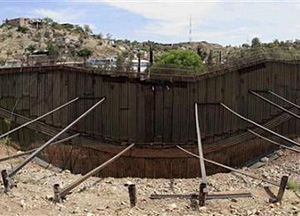 |
 |
 |
 News from Around the Americas | December 2006 News from Around the Americas | December 2006  
US Applies Afghan War Tactics on Mexican Border
 Bernd Debusmann - Reuters Bernd Debusmann - Reuters


| | A view of an area of the wall separating Mexico from the United States, being reinforced by the U.S. Border Patrol, in Nogales, Arizona with Nogales, Sonora, Mexico in the background in this May 21, 2006 file photo. (Jeff Topping/Reuters) |
The United States has begun to apply tactics perfected in the war in Afghanistan to tighten control of the border with Mexico, using a mix of age-old hunting techniques and high-tech spy-in-the-sky surveillance.

On the ground, U.S. Border Patrol agents on horseback, on foot, and in all-terrain vehicles scour the desert for the footprints of illegal border crossers so they can pursue and arrest them.

"Tracking and signcutting are essential skills for us," said Border Patrol Agent Jeffrey Smith. "They are as old as time. What we do here is a mix of the very old and the very new."

The wave of illegal crossings from Mexico has become a contentious political problem. Last year, the U.S. border patrol made more than a million arrests and by some estimates for every crossing that fails, two succeed.

Smith, on a recent patrol, slowed his truck to a crawl and hefted a large spotlight fastened to a wooden pole out of the window. He drove on slowly through the still Arizona night, holding the light inches above the dirt alongside the track. "The closer the light is to the ground, the better you can spot footprints."

In the air, a civilian version of the Predator drone that made its battlefield debut in Afghanistan, trains sophisticated electro-optical infrared cameras on the border.

Radio communications link agents on the ground with the crew flying the aircraft from a cockpit in a trailer at Fort Huachuca at the edge of an army airfield 30 miles northwest of this border town.

The low-tech, high-tech interaction of men on the ground with pilot-less aircraft is a concept developed by the military in the mid-1990s and employed extensively in Afghanistan.

There, aerial surveillance in combination with Global Satellite Positioning devices used by Special Forces soldiers on horseback played a decisive role in the war against the Taliban.

A similar interaction is now playing out along one of the most heavily-crossed -- and most hazardous stretches -- of the 2,000-mile border. In 2006, almost half the 441 people who died trying to cross between Mexico and the United States died along the border with Arizona.

Those who succeed have to evade three types of ground sensors -- vibration, magnetic and infrared. There are heat-sensing cameras atop tall poles, agents with night-vision goggles, and in the Naco area a 12-foot metal wall. Border patrol agents catch an average of 100 illegal crossers a day on this stretch of the frontier in Arizona alone.

The Border Patrol first started using an unmanned surveillance aircraft last year but the first Predator crashed in April near here.

Its $7.5 million successor began flying early in November, the first of 18 unmanned aerial vehicles the Border Patrol hopes to roll out by 2012 to tighten both the southern border with Mexico and the border with Canada, more than twice as long and thinly patrolled. No more than 300 Border Patrol agents are on duty on the northern border at any one time.

The aircraft are scheduled to form part of what President George W. Bush has termed "the most technologically advanced border security initiative in American history."

TINFOIL MAN AND BALLOON EFFECT

Illegal crossers are beginning to adapt, and some of the attempts to outsmart technology have become legend along the border. One Mexican thought he could avoid detection by heat-sensing cameras by covering himself head-to-toe with tinfoil meant to trap his body heat. It didn't work.

A group of smugglers drove trucks close to stationary cameras to make them swivel in their direction while others sprinted across in another direction. One "coyote" (people trafficker) instructed his clients to wear black clothes and paint their water bottles black to blend into the night.

"It's the world's most expensive game of hide-and-seek," said one border agent. "We come up with something new and they adapt and try and beat us."

High-tech surveillance from the sky is hoped to help counter what border experts term "the balloon effect" -- stick your finger into a balloon in one place and it bulges out in another. According to Border Patrol statistics, that happened after the government built a 14-mile border fence between San Diego in California and Tijuana in Mexico.

Illegal crossings along that stretch dropped sharply -- but increased in Arizona. Skeptics cite the balloon effect to argue that even constructing a 700-mile wall along the U.S.-Mexican border, a proposal Congress approved in September, would not stop clandestine cross-border traffic.

T.J. Bonner, head of the National Border Patrol Council, the union which represents most of the country's 12,000 border patrol agents, says neither a high technology virtual fence nor border walls will stop Mexicans as long as American employers give them jobs.

"You turn them back and they try again," he said. "And again, and again, and again." | 
 | |
 |



